If you’re planning to attend the Lebanese Festival from July 18–20 at St. Anthony’s Church in Cincinnati, get ready for an unforgettable culinary adventure! Lebanese food is celebrated worldwide for its fresh ingredients, bold flavors, and a perfect balance of spices. This festival offers a golden chance to savor authentic dishes that have been cherished for centuries, reflecting Lebanon’s rich cultural and culinary heritage.
Here’s an in-depth look at the top 5 authentic Lebanese dishes you absolutely must try at the festival:
1. Tabbouleh (تبولة) – The Fresh and Flavorful Salad
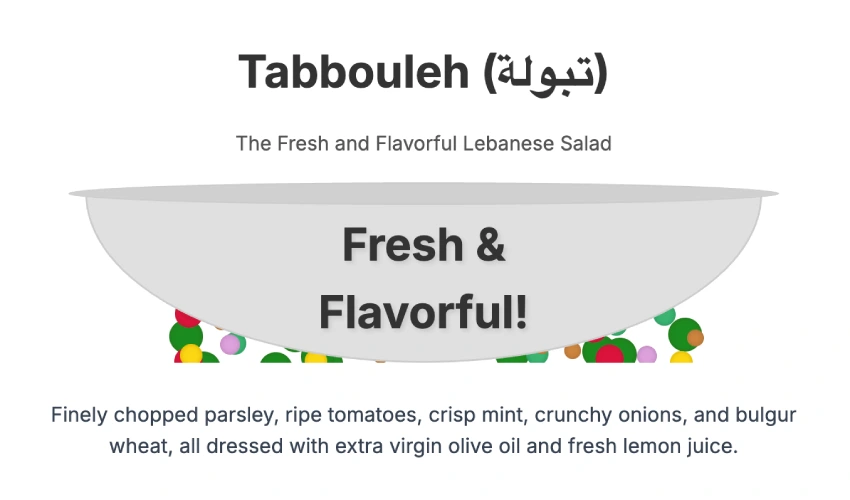
What is Tabbouleh?
Tabbouleh is a classic Lebanese salad famous for its refreshing and vibrant flavors. The base of this salad is finely chopped fresh parsley mixed with ripe tomatoes, crisp mint leaves, and crunchy onions. Bulgur wheat (cracked wheat) adds a nutty texture, soaking up the bright dressing made from extra virgin olive oil and freshly squeezed lemon juice. A pinch of salt and pepper finishes it off.
Why Is It Special?
Tabbouleh is more than just a salad; it’s a symbol of Lebanese freshness and healthy eating. It’s light, packed with vitamins, antioxidants, and fiber, making it a perfect complement to richer dishes. The zesty lemon and mint create a flavor explosion that’s both invigorating and satisfying. At the festival, you’ll find tabbouleh served fresh and made with love by locals who preserve the authentic taste passed down through generations.
How to Enjoy It
Enjoy tabbouleh on its own, or scoop it up with warm pita bread. It pairs wonderfully with grilled meats or fried kibbeh, balancing the meal with its bright, herby taste.
2. Kibbeh (كبة) – Lebanon’s National Dish
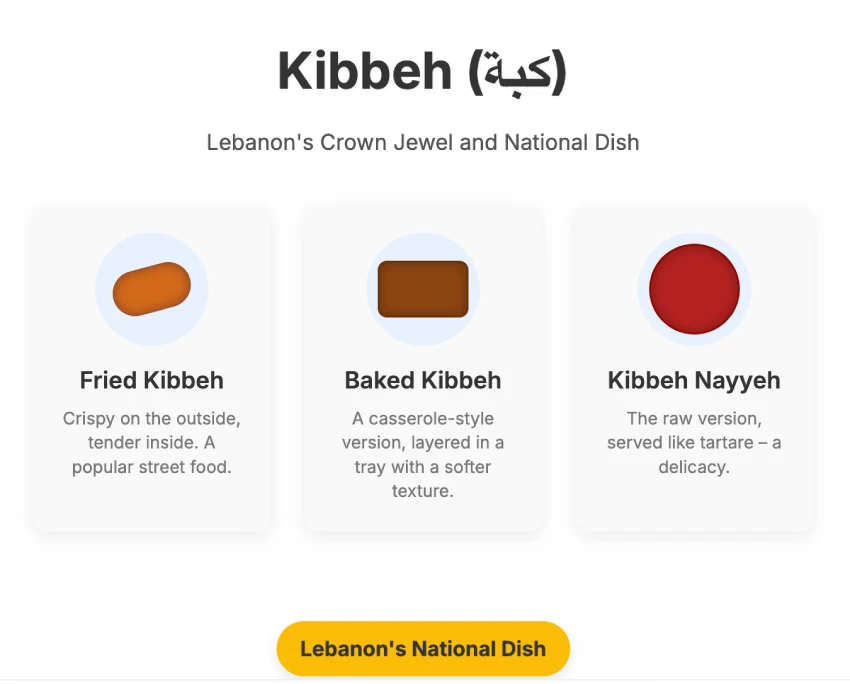
What is Kibbeh?
Kibbeh is often considered the crown jewel of Lebanese cuisine and is Lebanon’s national dish. It’s made from bulgur wheat, finely minced lamb or beef, onions, and a unique blend of spices including cinnamon, allspice, and nutmeg. The mixture is shaped into oval or football-like patties or balls, sometimes stuffed with a savory filling of spiced meat and pine nuts.
Cooking Styles
Kibbeh can be served in multiple ways:
- Fried Kibbeh: Crispy and golden on the outside, tender inside — a popular street food.
- Baked Kibbeh: A casserole-style version layered in a tray, softer texture.
- Kibbeh Nayyeh: A raw version served like tartare, a delicacy for many Lebanese.
Why Try Kibbeh?
Kibbeh combines rich, aromatic spices with a satisfying texture. The contrast between crunchy outside and juicy filling (if stuffed) makes it irresistible. It’s a dish that tells a story of Lebanon’s culinary artistry and is often served during special occasions and family gatherings.
3. Manakish (مناقيش) – The Lebanese Flatbread
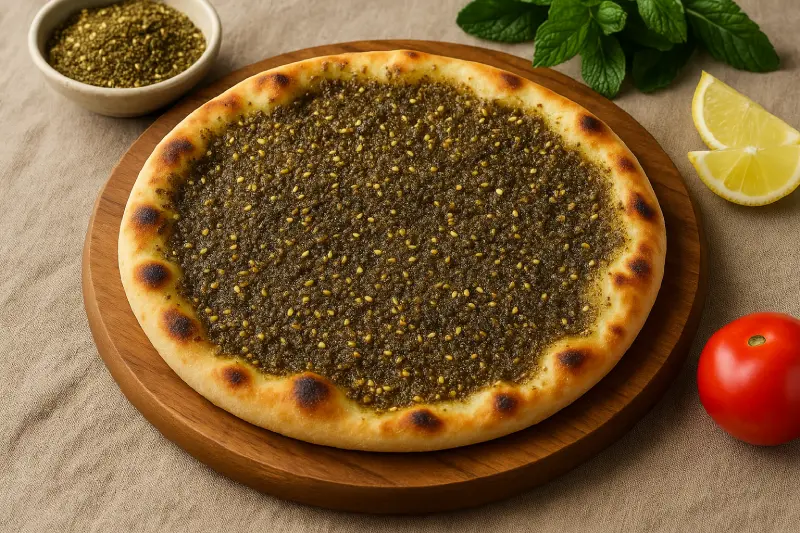
What is Manakish?
Manakish is sometimes called the “Lebanese pizza.” It’s a round, flatbread dough topped with flavorful ingredients and baked to perfection. The most common topping is za’atar, a fragrant blend of thyme, sesame seeds, and sumac, mixed with olive oil. Other popular toppings include cheese (like akkawi or mozzarella) and spiced ground meat.
Why It’s Popular
Manakish is beloved for being both a hearty and quick meal or snack. It’s often eaten for breakfast or lunch in Lebanon, fresh out of the oven and warm. The crispy yet chewy texture of the bread combined with the aromatic toppings makes every bite a delightful experience.
How to Enjoy Manakish
Try it fresh from the festival vendor with a side of labneh (strained yogurt) or olives. It’s a great option if you want a flavorful, filling bite while exploring the festival.
4. Hummus (حمص) – Creamy Chickpea Dip
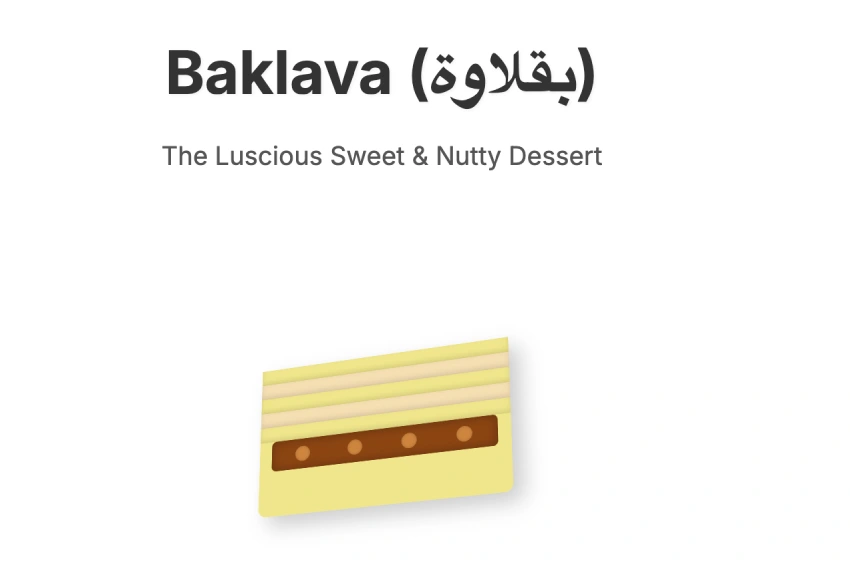
What is Hummus?
Hummus is arguably one of the most famous Middle Eastern dishes worldwide, and Lebanese hummus is a gold standard. It’s a smooth, creamy dip made from cooked and mashed chickpeas blended with tahini (sesame seed paste), fresh lemon juice, garlic, and topped with olive oil and sometimes a sprinkle of paprika or pine nuts.
Why You Should Try It
While hummus is common globally, Lebanese hummus stands out for its fresh ingredients and balance of flavors. The tahini adds a nutty creaminess, the lemon juice gives it brightness, and the garlic adds a mild pungency. It’s rich in protein, fiber, and healthy fats, making it a nutritious and satisfying choice.
How to Eat Hummus at the Festival
Hummus is traditionally served with warm, soft pita bread. At the festival, you can enjoy it as a dip or spread on bread with fresh veggies. It also pairs well with grilled meats and salads.
5. Baklava (بقلاوة) – Sweet and Nutty Dessert
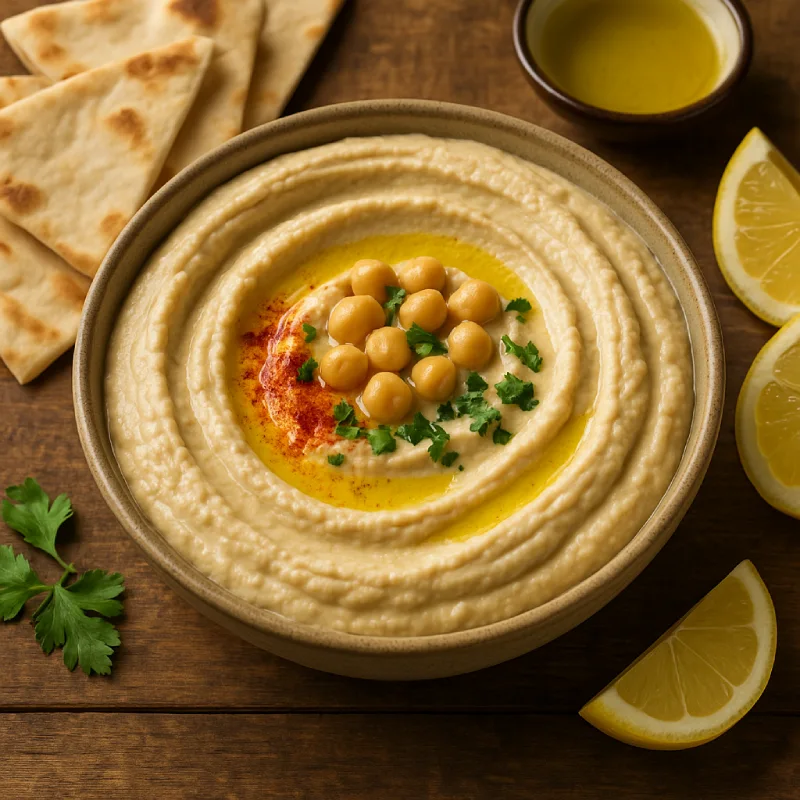
What is Baklava?
Baklava is a luscious, sweet dessert made from layers of ultra-thin phyllo dough filled with chopped nuts — usually pistachios, walnuts, or almonds. After baking, it’s drenched in fragrant syrup made with honey, sugar, and often infused with rosewater or orange blossom water.
What Makes It Irresistible?
Baklava is famous for its perfect balance of crunchy texture and sticky sweetness. Each bite combines the crisp layers of phyllo with the nutty filling and the syrup’s delicate floral aroma. It’s a celebratory dessert in Lebanon, often served during festivals, weddings, and holidays.
How to Enjoy Baklava
Enjoy a small piece as a perfect sweet finish to your festival feast. Pair it with Arabic coffee or mint tea for an authentic experience.
Bonus Tips for Enjoying Lebanese Cuisine at the Festival
- Beverage Pairings: Traditional mint tea or fresh lemonade complement the rich flavors of Lebanese food and provide a refreshing balance.
- Ask the Vendors: Lebanese hospitality means you’ll often get stories behind each dish — don’t hesitate to ask about ingredients and preparation methods.
- Try Variety: Lebanese cuisine offers a wide spectrum of tastes, from savory to sweet and everything in between. Sampling multiple dishes will give you the full cultural experience.
- Be Adventurous: If you see dishes like kibbeh nayyeh (raw kibbeh) or other less common items, give them a try if you’re comfortable — they’re local favorites!
Conclusion
The Lebanese Festival in Cincinnati is not just a feast for the senses but a cultural celebration that connects food lovers with Lebanon’s rich heritage. These five dishes represent the best of Lebanese culinary art and are essential for anyone wanting to experience authentic Middle Eastern flavors.
Mark your calendars for July 18–20, and get ready to embark on a delicious journey through Lebanese culture — one bite at a time!




